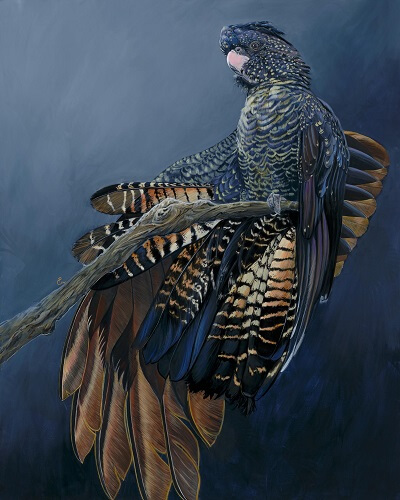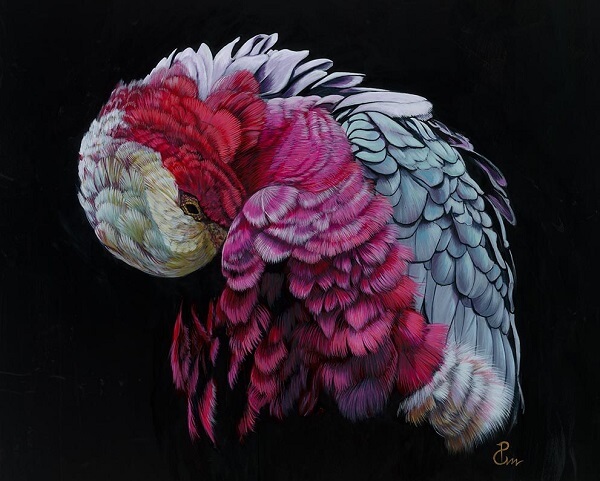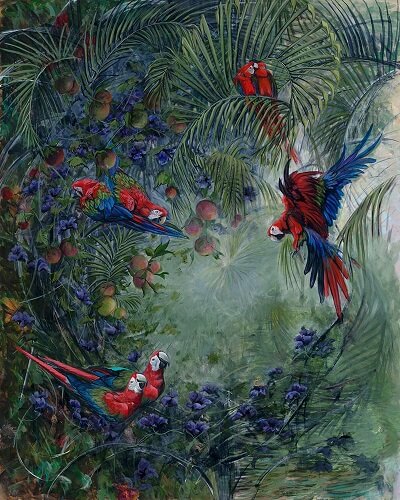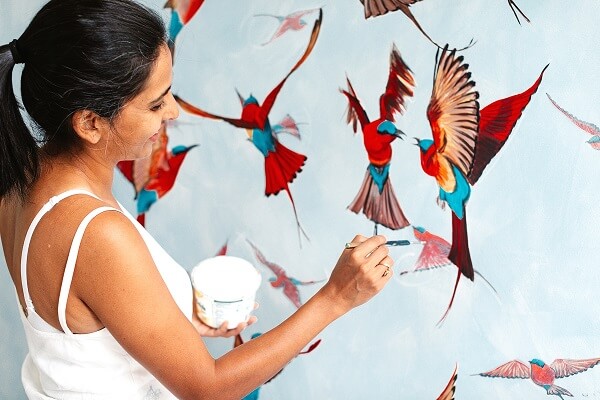In Aboriginal Australian culture, black cockatoos symbolise change, freedom and renewal. Similarly, in Priya Gore’s painting ‘I Am’, this bird represents empowerment, reflection, and interconnectedness.
Priya Gore’s body of work on winged creatures draws its essence from the unique journey of self-realisation, embodied in her upbringing. Gore, now 37, remembers her childhood, when she watched her father, an orthopaedic surgeon, and gynaecologist mother, save and bring new lives into the world. They encouraged Gore not to follow the conventional societal norms but to explore her own sense of self. Her opinions were valued when she was as little as three. And so, very early on she learned to identify her weaknesses, strengths, and the role she plays on this planet.
In similar spirit, her acrylic painting ‘I Am’ embodies the courage to embark on a path of self-discovery without fear of the unknown.

Earlier this year, the Brisbane-based artist showcased her avian-themed repertoire at The Other Art Fair in Sydney’s White Bay Cruise Terminal.
More recently, Gore earned the third prize in the wildlife edition of the International Artist Magazine for her piece ‘Love to Love’. The painting features birds symbolising her teenage years and the friendships she cherished. Amid the flock, however, one special friend stands out.
View this post on Instagram
An engineer finds her calling
Growing up in the small village of Gorewadi in Maharashtra’s Osmanabad district, Gore always had art in her soul, even if her journey took her far from it at first. She grew up with 27 cousins, but was the only one who was drawn to art.
“I feel that being an artist is not about getting inspired by external things to paint. It needs to come from within; the passion towards just expressing deep feelings,” she tells Indian Link.

Her early love for drawing was nurtured in a Marathi medium school, where she credits her art teachers, Ubale sir and Thorat sir, for their mastery of perspective and projection, a rarity in many government schools at the time. “I remember drawing a turtle on a slate with chalk when I was about three,” she recalls, noting how her father proudly showed off her first artwork to everyone.
But like many in India, Gore’s path was expected to follow a different course. Her family, deeply involved in medicine, to pursue the same field but she chose engineering. After completing her Masters in Telecommunications Engineering in Chicago, she thrived in her engineering career, working in the US before settling in Australia in 2014.
It was only after she arrived in Australia that Priya Gore found the time and space to re-explore her love for art. “Australia gave me time and the platform (nature) to look outside my computer and go for hikes and get inspired to paint a particular subject,” she shares.
This time led her to nature and wildlife, which soon became the central themes of her paintings.
View this post on Instagram
But as much as she would like to credit Australia’s vast natural beauty for reigniting her creative streak, Gore feels she got art from her ‘Maa’.
“Maa was supremely creative and artistic,” Gore adds. “I still feel when I paint today, she is the one guiding each of my strokes.”
A voice in the wilderness
In 2014, Priya Gore started painting alongside her engineering career. By 2016, she sold her first painting on the online art gallery Bluethumb. By 2018, she was selling her art consistently, and in 2022, she made the bold decision to pursue art full-time.
For Gore, every painting is like solving an engineering problem — a challenge that requires creativity and logic in equal measure. “I am an engineer at heart, but also an obsessive drawer,” she offers.
Her works, deeply influenced by the vibrant Australian landscape and its wildlife, are more than just depictions of nature; they are a commentary on human behaviours and life itself.

“Painting is like writing, communicating something deep within. Wildlife and nature are a mere subject matter I use to communicate my deep feelings about human behaviours and life.”
Her art, Gore believes, aims to convey that nature, in all its forms, has the power to heal, just as art does.
“My art tries to communicate that every living being on Earth is worth worshipping, noticing and respecting,” she says. “I believe a tiny bug on a leaf deserves the same or more respect than an individual human being. Once we humans understand this, things might start falling into perspective to achieve true harmony on this planet.”
READ ALSO: Perth artist Dena Lawrence’s work on Kashmiri silk carpets





